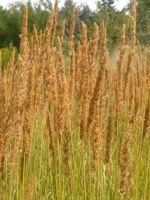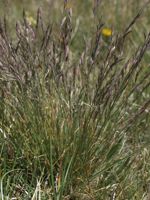Mon-Fri 9am - 5pm Mountain time
Slimstem Reedgrass vs Rocky Mountain Fescue
Calamagrostis stricta
Festuca saximontana
CUSTOM GROW
CUSTOM GROW
Slimstem Reedgrass is a native perennial bunchgrass commonly found in damp meadows, wetlands, and along streams and lakeshores. It thrives in wet, nutrient-poor soils and shows some tolerance to saline conditions. Typically a bunchgrass, it can also spread by rhizomes to form colonies, making it well-suited for soil stabilization, riparian zone planting, and wetland restoration projects.
Slimstem Reedgrass provides valuable cover for small animals and birds, and its dense growth can even serve as nesting habitat for waterfowl in wetland areas. Its seeds offer forage for wildlife, while the tall stems and floral spikes add texture and visual interest to the landscape.
Rocky Mountain Fescue is a native perennial bunchgrass recognized for its fine-textured clumps and adaptability to harsh environments. It grows well in dry, rocky, and nutrient-poor soils and is highly cold-tolerant, making it well-suited to both prairie and alpine habitats. Its fibrous root system contributes to soil stability and helps reduce erosion on slopes and shallow soils.
Widespread across western and northern North America, Rocky Mountain Fescue is an important component of many prairie and alpine ecosystems. It contributes ground cover and organic matter that support soil function, provides cover for small wildlife, and offers moderate forage for grazing animals. Hardy and versatile, it is used in ecological restoration, naturalization, and habitat enhancement projects, particularly in upland and alpine landscapes.

